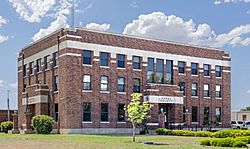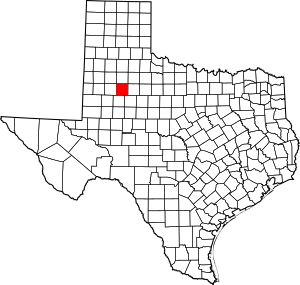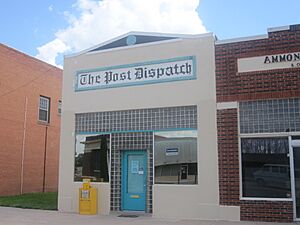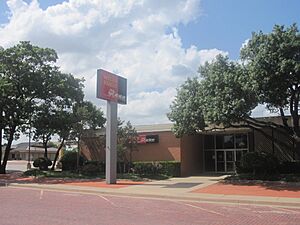Garza County, Texas facts for kids
Quick facts for kids
Garza County
|
|
|---|---|
|
County
|
|

Garza County Courthouse in Post
|
|

Location within the U.S. state of Texas
|
|
 Texas's location within the U.S. |
|
| Country | |
| State | |
| Founded | 1907 |
| Seat | Post |
| Largest city | Post |
| Area | |
| • Total | 896 sq mi (2,320 km2) |
| • Land | 893 sq mi (2,310 km2) |
| • Water | 2.8 sq mi (7 km2) 0.3% |
| Population
(2020)
|
|
| • Total | 5,816 |
| • Density | 6.491/sq mi (2.5062/km2) |
| Time zone | UTC−6 (Central) |
| • Summer (DST) | UTC−5 (CDT) |
| Congressional district | 19th |

Garza County is a special area in the state of Texas. It is like a large district with its own local government. In 2020, about 5,816 people lived here. Most of them live in the main town, Post, which is also the county seat.
Garza County was created in 1876 and officially started its government in 1907. It was named after a well-known family from Bexar County, because this area used to be part of that county.
Contents
History of Garza County
Early Inhabitants
Long ago, around 2000 BC, the first people lived in the Garza County area. These were Native American groups. Later, the Kiowa and Comanche tribes lived here.
Ranches and Settlements
In 1875, two men, W. C. Young and Ben Galbraith, started the Curry Comb Ranch. This was one of the first big ranches in the area. Garza County was officially formed in 1876. It was named after the important Garza family from Bexar County.
By 1880, only 36 people lived in the county. A few years later, in 1882, the Square and Compass Ranch began. They were the first to use barbed wire fences in 1884. The OS Ranch was also started in 1884 by brothers Andrew and Frank Long.
Founding of Post
By 1900, the county's population grew to 185 people. The town of Post was founded in 1907. It was started by C.W. Post, a famous person who made breakfast cereals. He wanted to create a perfect community there.
From 1909 to 1913, C.W. Post built a cotton gin and a cotton mill in Post. He even tried to make it rain more for farming. He used explosives fired from kites and towers to try and change the weather!
Discoveries and Growth
In 1926, oil was found in Garza County, which helped the economy. A cool discovery happened in 1934. Quanah and Bryan Maxey found a huge, 16-foot-long tusk from a prehistoric mammoth. You can see this tusk today at the American Museum of Natural History in New York City.
Later, between 1960 and 1965, archaeologists studied an ancient Native American site at Cowhead Mesa. They found tools and other items that showed people lived there as far back as 2000 BC. By 1980, the main businesses in Garza County were farming, oil, and textile factories.
Geography of Garza County
Garza County covers about 896 square miles. Most of this is land, with only a small part being water. It is located southeast of Lubbock, in a unique area called the Canyonlands of the Llano Estacado Escarpment.
Main Roads and Highways
These are the important roads that go through Garza County:
Neighboring Counties
Garza County shares borders with these other counties:
- Crosby County (to the north)
- Dickens County (to the northeast)
- Kent County (to the east)
- Scurry County (to the southeast)
- Borden County (to the south)
- Lynn County (to the west)
- Lubbock County (to the northwest)
People of Garza County
| Historical population | |||
|---|---|---|---|
| Census | Pop. | %± | |
| 1880 | 36 | — | |
| 1890 | 14 | −61.1% | |
| 1900 | 185 | 1,221.4% | |
| 1910 | 1,995 | 978.4% | |
| 1920 | 4,253 | 113.2% | |
| 1930 | 5,586 | 31.3% | |
| 1940 | 5,678 | 1.6% | |
| 1950 | 6,281 | 10.6% | |
| 1960 | 6,611 | 5.3% | |
| 1970 | 5,289 | −20.0% | |
| 1980 | 5,336 | 0.9% | |
| 1990 | 5,143 | −3.6% | |
| 2000 | 4,872 | −5.3% | |
| 2010 | 6,461 | 32.6% | |
| 2020 | 5,816 | −10.0% | |
| U.S. Decennial Census 1850–2010 2010 2020 |
|||
In 2000, there were 4,872 people living in Garza County. About 36% of the homes had children under 18. The average age of people in the county was 35 years old.
The median income for a family in the county was about $31,173 per year. This means half of the families earned more than that, and half earned less. About 22% of the population lived below the poverty line.
Communities in Garza County
City
- Post (This is the main town and where the county government is located.)
Other Communities
These smaller communities are also part of Garza County:
Education in Garza County
Students in Garza County attend schools in these districts:
- Crosbyton Consolidated Independent School District
- Post Independent School District
- Southland Independent School District
For college, the county is served by South Plains College.
See also
 In Spanish: Condado de Garza para niños
In Spanish: Condado de Garza para niños


